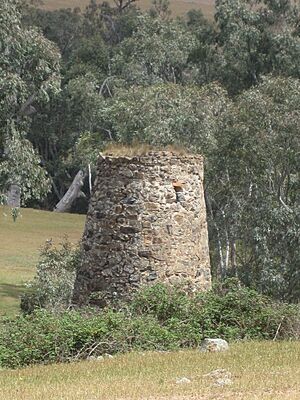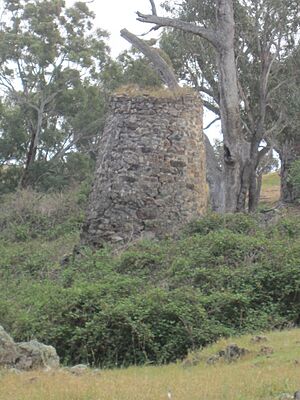Bogolong iron mine and blast furnace facts for kids
The Bogolong iron mine and blast furnace is an old mining and iron-making site. It is found near Bookham, New South Wales, in Australia. This area is mostly known for raising sheep. People sometimes call this place Australia's 'forgotten furnace'.
In 1874, this blast furnace made a small amount of iron. This iron was tested and found to be good quality. However, plans to make iron here for sale never happened. The site is important because it is one of only three old 19th-century iron furnaces left in Australia. It is also the only one in New South Wales.
Contents
Where is Bogolong?
The old iron mine and the furnace ruin are next to a part of Jugiong Creek. In the 1800s, this part was called Bogolong Creek. The site is about 3 kilometres north of the small town of Bookham. It sits on the north side of a big bend in Jugiong Creek.
Why was it built?
In the early 1870s, the price of iron went up a lot. This made people want to make iron in Australia. It became cheaper to make iron here than to buy it from other countries. But these high prices did not last long. By the late 1870s, imported iron became cheap again. This was because it was often shipped as heavy cargo on sailing ships.
In the 1800s, the whole area around Bookham was known as Bogolong. The Main Southern Railway was being built. By 1876, it reached Binalong. This town is north of the Bogolong site. The railway would have helped transport iron to Sydney and Melbourne.
The Iron Ore
The rock used to make iron is called iron ore. A test of the iron ore from Bogolong in the 1800s showed it had 52% metallic iron. The ore was a type called hematite. People said this ore was better than the ore from the Fitzroy Iron Works. The iron ore was described as "Specular hematite of excellent quality". It was thought there was a lot of this ore. However, it was hard to tell exactly how much. This was because the main rock was hidden by soil.
How it Worked
In late 1873, a new company was started. It was called the Bogolong Iron Mining Company. They rented about 80 hectares of land. This land was next to what was then Bogolong Creek. The company owners were local men from Bookham. There were also investors from Albury and a manager from Daylesford.
From July 1873, seven workers dug for iron ore. A blast furnace was built next to the mine. On March 31, 1874, five blocks of iron were made. These blocks are called 'pigs' of iron. But there were problems right away. The special bricks inside the furnace could not handle the heat. So, they stopped working to fix it.
Four more iron pigs were made on May 20, 1874. All nine iron pigs were sent to Melbourne to check their quality. No more iron was made at the site after that. There were plans for a bigger company to make iron for sale. But these plans never happened. The furnace and mine were left empty. In August 1875, some English investors were interested in buying the mine. But nothing came of those plans either.
How they made iron
The blast furnace was 6 metres tall. This was quite small, even for its time. It had a square base. It also had three openings for air (called tuyeres). There was an arched opening on the south side. This is where the melted iron and waste (slag) came out. They flowed onto a flat area nearby.
The outside of the furnace was made of local stone. The inside was lined with special bricks made nearby. The space between the outer stone and inner bricks was filled with clay. These inner bricks were not strong enough. They broke quickly when the furnace got hot. This is why so little iron was made.
The furnace used a "cold-blast" method. This means cold air was blown into it. A 10 h.p. steam engine powered a machine that blew the air. There was a wooden bridge from the top of a hill to the top of the furnace. Workers used wheelbarrows to move raw materials across this bridge. They then dropped them into the furnace.
The furnace was heated using charcoal. This charcoal was made from local hardwood trees. Limestone was also used. It helped the iron melt better. The limestone was dug up nearby, probably from the company's own land. But its exact location is not known today.
Quality of the Iron
The iron pigs made in March and May 1874 were very good quality. When they were checked in Albury, people said the first five pigs were "far superior" to iron from another mine. This other mine was the Ilfracombe Iron Mine in Tasmania.
What's Left Today
The remains of the mine and furnace are on private land. You cannot visit them. But you can see parts of them from a public road. This road is called Illalong Road. It runs between Bookham and Binalong.
The mine site is an open pit. Piles of iron ore and limestone are still there. These were dug up in 1873 and 1874. They are found between the mine and the furnace.
The furnace ruin and the casting floor are nearby. They are on a flat area made by people. This area is partway down a hill that leads to Jugiong Creek. By 1993, there was no sign of the blowing equipment or other machines. The outer stone shell of the furnace was still complete in 1993. But many of the inner bricks had been taken over the years.
Since 1993, the ruin has been partly covered by blackberry bushes. Some important wooden beams have also rotted. By 2010, people had taken stones from the top of the furnace. This made it weaker. It was in danger of falling down. But the furnace was still standing in October 2019.
The Bogolong furnace is one of only three 19th-century iron furnace ruins left in Australia. It is the only one in New South Wales. The site is important for its history. But it is not being looked after as a historical site. It is still known as the 'forgotten furnace'.
Images for kids




